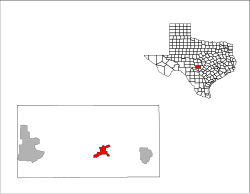Fredericksburg, Texas Friedrichsburg | |
|---|---|
 East end of downtown Fredericksburg | |
| Nicknames: Fritztown, | |
 Location of Fredericksburg, Texas | |
 | |
| Coordinates: 30°15′50″N98°52′29″W / 30.26389°N 98.87472°W | |
| Country | |
| State | Texas |
| County | Gillespie |
| Named after | Prince Frederick of Prussia |
| Area | |
• Total | 9.25 sq mi (23.95 km2) |
| • Land | 9.19 sq mi (23.81 km2) |
| • Water | 0.054 sq mi (0.14 km2) |
| Elevation | 1,723 ft (525 m) |
| Population (2020) | |
• Total | 10,875 |
| • Density | 1,183/sq mi (456.7/km2) |
| Time zone | UTC−06:00 (Central (CST)) |
| • Summer (DST) | UTC−05:00 (CDT) |
| ZIP Code | 78624 |
| Area code | 830 |
| FIPS code | 48-27348 [3] |
| GNIS feature ID | 2410542 [2] |
| Website | www |
Fredericksburg (German : Friedrichsburg) is a city in and the county seat of Gillespie County, Texas, United States. [4] As of the 2020 Census, this city had a population of 10,875. [5]
Contents
- History
- Geography
- Enchanted Rock
- Balanced Rock
- Cross Mountain
- Climate
- Architecture
- Churches and religion
- Nimitz Hotel and National Museum of the Pacific War
- Railway
- Agritourism
- Education
- Friends of Gillespie County Country Schools
- Hospitals
- Transportation
- Major roads
- Airport
- Demographics
- 2023 census
- 2000 census
- Government
- Media
- Radio
- Newspapers
- In popular culture
- Notable people
- Gallery
- See also
- Notes
- References
- Further reading
- External links
Fredericksburg was founded in 1846 and named after Prince Frederick of Prussia. Old-time German residents often referred to Fredericksburg as Fritztown, a nickname that is still used in some businesses. [6] It is located 70 miles northwest of San Antonio, and approximately 80 miles west of Austin. This city is also notable as the center of Texas German, a dialect spoken by the first generations of German settlers who initially refused to learn English. Fredericksburg shares many cultural characteristics with New Braunfels, which had been established by Prince Carl of Solms-Braunfels the previous year. Fredericksburg is the birthplace of Fleet Admiral Chester Nimitz. It is the sister city of Montabaur, Germany. [7] On October 14, 1970, the Fredericksburg Historic District was added to the National Register of Historic Places in Texas. [8]






















